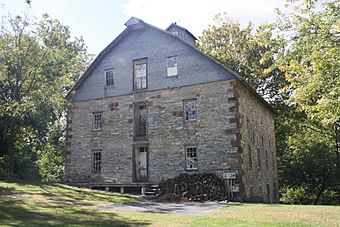Tulpehocken Creek Historic District facts for kids
Quick facts for kids |
|
|
Tulpehocken Creek Historic District
|
|

Mill in Womelsdorf. September 2013.
|
|
| Location | Tulpehocken and Mill Creeks from Berks-Lebanon line to Blue March Dam between Millardsville and Bernville, Marion Township, North Heidelberg Township, and Lower Heidelberg Township, Pennsylvania |
|---|---|
| Area | 1,700 acres (690 ha) |
| Built | 1723 |
| Architectural style | Colonial German |
| NRHP reference No. | 85000672 |
| Added to NRHP | March 28, 1985 |
The Tulpehocken Creek Historic District is a special area in Berks County, Pennsylvania. It is recognized as a national historic district. This means it has important buildings and places from the past.
The district covers about 1,700 acres. It stretches along the Tulpehocken Creek and Mill Creek. This area was very important for settlement and growth from the early 1700s to the late 1800s. It includes 152 old buildings, one historic site, and four structures. These show how people lived and worked here long ago.
Some of the old buildings include log cabins from the 1720s. There are also buildings from the Charming Forge community, which made iron. You can also find old churches, farms, and structures linked to the Union Canal. This district was added to the National Register of Historic Places in 1985.
Contents
History of Tulpehocken Creek
The Tulpehocken Creek area is very important to the history of Western Berks County. It was one of the first places where German families settled in Pennsylvania. These families came from Schoharie, New York, in the 1720s. They traveled a long way by water, using the Susquehanna, Swatara, and Tulpehocken creeks. This journey led them to their new homes.
German Settlers Arrive
Historians say the Tulpehocken settlement started a big movement of people. Many German families moved to Pennsylvania during colonial times. The first settlers in Tulpehocken were part of a larger group. This group of about 4,000 Palatine Germans had first settled in New York in 1710.
They had a hard time in New York. They couldn't make enough tar for the Queen's Navy, which was their original plan. They also struggled to get land for farming. So, many families decided to move. They traveled in groups of 15 to 50 families to the Tulpehocken area.
Conrad Weiser's Role
Many of these settlers were guided by Conrad Weiser. He was a famous Pennsylvania Dutch pioneer. Weiser was also an interpreter and diplomat. He helped connect the Pennsylvania Colony with Native American groups.
Why the Boundaries Were Chosen
The borders of the Tulpehocken Creek Historic District were chosen carefully. The western border is the line between Berks and Lebanon counties. This is an old, easy-to-understand historical boundary from 1752.
The eastern edge of the district is the Blue Marsh Lake. This area changed a lot when the creek was dammed. Many historic sites along the stream were flooded. So, the lake makes a clear and easy-to-find boundary. The Tulpehocken Creek Historic District was officially listed on the National Register of Historic Places in 1985.
Notable Buildings and Structures
The Tulpehocken Historic District has many interesting old buildings. These show how people lived and worked along the upper Tulpehocken Creek. Here are some examples:
- Early Log Cabins: Some of the oldest buildings are log cabins from 1723 to 1750. These include 1-1/2-story cabins built by Godfrey Fidler and Frederick Reed.
- Reed's Cemetery: This cemetery dates back to 1723. It shows how early settlers buried their loved ones.
- Christ Little Tulpehocken Church: The first log church was built here in 1730. The church building you see today was built in 1809.
- Charming Forge: This was an important iron-making community from 1749 to 1895. It was the most important industrial site in the area. It includes a large Georgian mansion built by George Ege in 1784.
- Christ Lutheran Church: The original log church was built in 1743. The current church building was constructed in 1786.
- Historic Farm Complexes: Many farms from the 1700s and 1800s are still here. They were built in the German style. You can see stone and log houses, barns, and gristmills.
- Union Canal Buildings: There are also buildings related to the Union Canal. This canal operated from 1827 to 1884 and was important for transportation.



